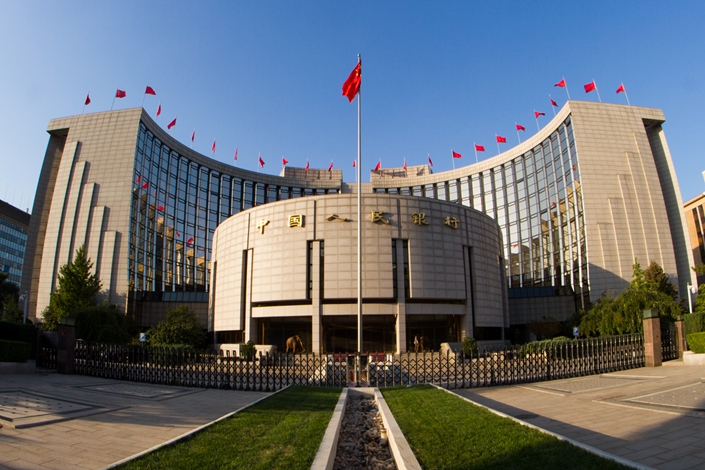China’s Central Bank Lays Out Top Tasks to Tackle in 2020

The People’s Bank of China (PBOC) has outlined its key priorities and tasks for 2020 after a two-day meeting to set its policy agenda, pledging to win the battle to defuse financial risks, improve and expand the scope of its macro-prudential regulation, and strengthen counter-cyclical policies to support economic growth.
The central bank also vowed to keep monetary policy prudent, flexible and appropriate, according to a statement (link in Chinese) posted Sunday on its website summarizing the meeting which was attended by PBOC officials including Governor Yi Gang, Party Secretary Guo Shuqing, deputy governors and the heads of regional bureaus around the country.
The statement echoed the main themes outlined by China’s top leadership at the Politburo meeting and the Central Economic Work Conference, the government’s annual economic policy-setting gathering, in December. These include implementing a prudent monetary policy stance, pursuing supply-side structural reform in the financial sector, deepening reform and opening up, and promoting stable growth.
The government started a three-year campaign in 2018 to prevent and resolve major financial risks, one of the “three critical battles” outlined at the annual Central Economic Work Conference in December 2017. The PBOC’s statement said that 2020 would be a year to “resolutely win the battle.”
More accountability
As part of the strategy, the PBOC said it would set up a mechanism that would enable local offices of the Financial Stability and Development Committee (FSDC) to coordinate with local financial regulators. The cabinet-level committee was set up in 2017 to coordinate the various agencies that oversee the country’s sprawling financial sector and formulate policies to control financial risks.
The FSDC will set up offices in every provincial branch of the central bank, an official from a local branch told Caixin, allowing officials in PBOC branches to supervise other financial regulators at the city or county level in the name of the committee. The PBOC currently only has the authority to manage its own branches and does not have the power to punish or take action against other local watchdogs.
The central bank also vowed to improve the macro-prudential regulation framework through measures that will include expanding the areas covered by the policy, setting up a stress-test system and a macro-prudential regulation system for cross-border capital flows. Macro-prudential regulation aims to reduce the risk and the macroeconomic costs of financial instability and uses various indicators to measure systemic risk. The PBOC introduced a Macro-Prudential Assessment (MPA) framework in early 2017 to evaluate banks across a range of criteria such as bad debts, exposure to credit risk and capital adequacy.
This is the first time the central bank has pledged to expand coverage of its macro-prudential regulation and follows a recommendation by the International Monetary Fund in its 2017 report, “Modernizing China: Investing in Soft Infrastructure,” to broaden the reach of its framework to cover suppliers of credit and liquidity other than banks.
The PBOC flagged that fintech, an emerging industry where financial services companies use technology to improve the products and services they offer customers, is becoming an increasingly important part of its supervisory work. The work meeting statement said that in 2020, the central bank will implement a fintech development plan, and improve the regulatory system for fintech supervision.
Digital currency was also highlighted, with the PBOC pledging to steadily advance research and development into its proposed digital currency.
More fine-tuning
In terms of monetary policy, the PBOC statement had a slightly different wording from last year’s work meeting summary, saying that while monetary policy would be prudent, it should also be flexible and appropriate. That compares with the 2019 wording that it should be “neither too tight nor too loose.” This year’s meeting also reiterated that the central bank will further strengthen counter-cyclical adjustments, and increase the frequency and intensity of policy fine-tuning when necessary.
The central bank has already shown its willingness to act, announcing on Jan. 1 a 50 basis-point reduction in commercial banks’ required reserve ratios, a move that will unleash about 800 billion yuan ($115 billion) of liquidity into the financial system. The policy took effect on Monday.
Economists from Nomura International (Hong Kong) Ltd. said that the cut signals Beijing’s heightened concerns of economic growth headwinds, pressure on credit contraction, and an upcoming liquidity shortage ahead of, and during, the Lunar New Year holiday, which begins on Jan. 24.
Contact reporter Guo Yingzhe (yingzheguo@caixin.com)
Caixin Global has launched Caixin CEIC Mobile, the mobile-only version of its world-class macroeconomic data platform.
If you’re using the Caixin app, please click here. If you haven’t downloaded the app, please click here.

- GALLERY
- PODCAST
- MOST POPULAR





